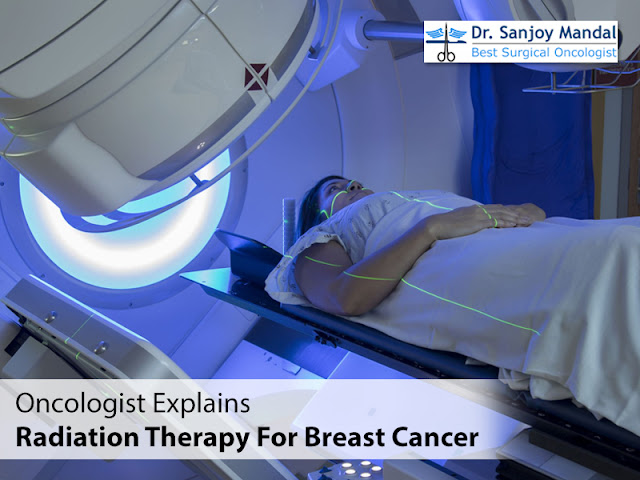Introduction
Radiation treatment for breast cancer uses high-energy
X-rays, protons, or other particles to destroy cancer cells. Rapidly developing
cancer cells are more exposed to the effects of radiation therapy than normal
cells. The X-rays or particles are painless, invisible and safe, says the best cancer doctor in Kolkata. Radiation
therapy delivers therapy for breast cancer through:
External radiation
A machine is
used to deliver radiation from outside a person's body to the breast. It is the
most common form of radiation therapy that is used for breast cancer.
Internal radiation (brachytherapy)
After a person undergoes surgery to remove cancer, the
doctor temporarily places a radiation-delivery device in their breast in the
area where the tumour was located.
Why it's done
Radiation therapy destroys cancer cells. It's often
used after surgery to decrease the risk of cancer recurrence. It can also
relieve pain and other signs of advanced breast cancer, says an oncologist specialist in Kolkata. Radiation
therapy is employed to treat breast cancer at almost every stage.
Radiation after lumpectomy
If a person undergoes an operation only to extract the
breast cancer, leaving the surrounding healthy tissues intact, the doctor
recommends radiation after the operation. The radiation helps kill the
remaining cancer cells, decreasing the risk of recurrence.
Lumpectomy in combination with radiation therapy is
often referred to as breast conservation therapy. In cases where the chance of
recurrence is very low, a doctor may also discuss the option of avoiding
radiation after a lumpectomy. After lumpectomy, radiation treatment choices
might include:
- Radiation to the entire breast - One of the most common radiation
therapy used after a lumpectomy is external beam radiation of the whole
breast.
- Radiation to some parts of the breast - Radiation therapy to parts
of the breast is an option for some early-stage breast cancers. This
method directs internal or external radiation to the area from where the
tumour was removed.
Radiation after mastectomy
Radiation can also be used after mastectomy. In this
situation, the radiation helps kill any cancer cells that might remain. It also
reduces the risk that cancer may recur in the remaining tissues of the chest
wall or lymph nodes. To determine whether you should undergo radiation after
mastectomy, your doctor considers whether you have:
- Lymph nodes with breast cancer signs - Underarm (axillary) lymph
nodes that test positive for cancer cells signify that some cancer cells
have spread beyond the breast.
- Large tumor size - A breast cancer larger than about 2 inches (5
centimeters) generally carries a higher risk of recurrence than smaller
cancers.
- Tissue margins with symptoms of breast cancer - After the removal
of breast tissues, the margins of the tissue are examined. Very thin
margins or margins that test positive for cancer cells have a risk of
recurrence, says best cancer doctor in Kolkata.
Radiation for locally advanced breast cancer
Radiation treatment can also be used to treat:
- Breast cancers that cannot be extracted after surgery
- Inflammatory breast cancer is an aggressive type of cancer that
spreads to the lymph channels of the skin covering the breast. This type
of cancer is treated using chemotherapy before a mastectomy. It is
followed by radiation to decrease the chance of recurrence.




0 Comments